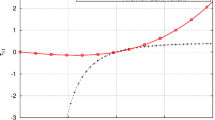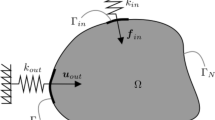Abstract
This paper presents a new method for topology optimization of geometrical nonlinear compliant mechanisms using the element-free Galerkin method (EFGM). The EFGM is employed as an alternative scheme to numerically solve the state equations by fully taking advantage of its capability in dealing with large displacement problems. In the meshless method, the imposition of essential boundary conditions is also addressed. The popularly studied solid isotropic material with the penalization (SIMP) scheme is used to represent the nonlinear dependence between material properties and regularized discrete densities. The output displacement is regarded as the objective function and the adjoint method is applied to finding the sensitivity of the design functions. As a result, the optimization of compliant mechanisms is mathematically established as a nonlinear programming problem, to which the method of moving asymptotes (MMA) belonging to the sequential convex programming can be applied. The availability of the present method is finally demonstrated with several widely investigated numerical examples.
Similar content being viewed by others
References
Howell, L.L., Compliant Mechanisms. New York: John Wiley & Sons, Inc. 2001.
Howell, L.L. and Midha, A., A method for design of compliant mechanisms with small length flexural pivots. Journal of Mechanical Design, 1994, 116: 280–290.
Bendsøe, M.P. and Sigmund, O., Topology Optimization: Theory, Methods, and Applications. Berlin Heidelberg, New York: Springer), 2003.
Sigmund, O., On the design of compliant mechanisms using topology optimization. Mechanics of Structures and Machines, 1997, 25(3): 493–524.
Yin, L. and Ananthasuresh, G.K., Design of distributed compliant mechanisms. Mechanics Based Design of Structures and Machines, 2003, 31(2):151–179.
Wang, Y., Chen, S.K. and Wang, X.M. et al., Design of multimaterial compliant mechanisms using level-set methods. Journal of Mechanical Design, 2005, 127(55): 941–956.
Luo, Z., Tong, L.Y., Wang, M.Y. and Wang, S.Y., Shape and topology optimization of compliant mechanisms using a parameterization level set method. Journal of Computational Physics, 2007, 227(1): 680–705.
Ananthasuresh, G.K., Kota, S. and Gianchandani, Y., A methodical approach to the design of compliant micro-mechanisms//Technical Digest of the Solid-State Sensor and Actuator Workshop, Hilton Head Island, SC June 13–16, 1994, 189–192.
Bendsøe, M.P. and Kikuchi, N., Generating optimal topology in structural design using a homogenization method. Computer Methods in Applied Mechanics and Engineering, 1988, 71: 197–224.
Bendsøe, M.P. and Sigmund, O., Material interpolation schemes in topology optimization. Archive of Applied Mechanics, 1999, 69: 635–654.
Wang, Y., Wang, X.M. and Guo, D.M., A level set method for structural topology optimization. Computer Methods in Applied Mechanics and Engineering, 2003, 192: 227–246.
Mei, Y.L. and Wang, X.M., A level set method for microstructure design of composite materials. Acta Mechanica Solida Sinica, 2004, 17(3): 239–249.
Buhl, T., Pedersen, C.B.W. and Sigmund, O., Stiffness design of geometrically nonlinear structures using topology optimization. Structural and Multidisciplinary Optimization, 2000, 19(2): 93–104.
Pedersen, C.B.W., Buhl, T. and Sigmund, O., Topology synthesis of large-displacement compliant mechanisms. International Journal for Numerical Methods in Engineering, 2001, 50: 2683–2705.
Saxena, A. and Ananthasuresh, G.K., Topology synthesis of compliant mechanisms for nonlinear force-deflection and curved path specifications. ASME Journal of Mechanical Design, 2001, 123: 33–42.
Belyeschko, T., Krongauz, Y. and Organ, D. et al., Meshless methods: an overview and recent developments. Computer Methods in Applied Mechanics and Engineering, 1996, 39: 3–47.
Belytschko, T., Lu, Y.Y. and Gu, L., Element free Galerkin methods. International Journal for Numerical Methods in Engineering, 1994, 37: 229–256.
Liu, G.R., Mesh Free Method: Moving Beyond the Finite Element Method. USA: CRC Press, 2002.
Cho, S. and Kwak, J., Continuum-based topology design optimization using meshfree method. 5th World Congress of Structural and Multidisciplinary Optimization, Lido di Jesolo, Italy, May 19–23, 2003.
Cho, S. and Kwak, J., Topology design optimization of geometrically non-linear structures using meshfree method. Computer Methods in Applied Mechanics and Engineering, 2006, 195: 5909–5925.
Gu, Y.T. and Liu, G.R., Hybrid boundary point interpolation methods and their coupling with the element free Galerkin method. Engineering Analysis with Boundary Elements, 2003, 27(11): 905–917.
Zhang, X., Liu, X.H. and Song, K.Z. et al., Least-square collocation meshless method. International Journal for Numerical Methods in Engineering, 2001, 51(11): 1089–1100.
Belytschko, T., Organ, D. and Krongauz, Y., Coupled finite element-element-free Galerkin method. Computational Mechanics, 1995, 17(3): 186–195.
Zhang, X., Liu, X. and Lu, M.W. et al., Imposition of essential boundary conditions by displacement constraint equations in meshless methods. Communications in Numerical Methods in Engineering, 2001, 17(3): 165–178.
Rozvany, G.I.N., Topology Optimization in Structural Mechanics. Berlin Heidelberg: Springer, 1997.
Kota, S., Lu, K.J. and Kreiner, Z. et al., Design and application of compliant mechanisms for surgical tools. Journal of Biomechanical Engineering, 2005, 127(8): 981–989.
Luo, Z., Du, Y.X. and Chen, L.P. et al., Continuum topology optimization for monolithic compliant mechanisms of micro-actuators. Acta Mechanica Solida Sinica, 2006, 19(1): 58–68.
Zhou, M. and Rozvany, G.I.N., The COC algorithm, part II: topological, geometry and generalized shape optimization. Computer Methods in Applied Mechanics and Engineering, 1991, 89: 197–122.
Svanberg, K., The method of moving asymptotes: a new method for structural optimization. International Journal for Numerical Methods in Engineering, 1987, 24: 359–73.
Svanberg, K., A class of globally convergent optimization methods based on conservative convex separable approximations. SIAM Journal on Optimization, 2002, 12: 555–573.
Sigmund, O. and Petersson, J., Numerical instabilities in topology optimization: a survey on procedures dealing with checkerboards, mesh-dependencies and local minima. Structure and Multidisciplinary Optimization, 1998, 16: 68–75.
Luo, Z., Chen, L.P. and Yang, J.Z. et al., Compliant mechanism design using multi-objective topology optimization scheme of continuum structures. Structure and Multidisciplinary Optimization, 2005, 30(2): 142–154.
Diaz, A.R. and Sigmund, O., Checkerboard patterns in layout optimization. Structural and Multidisciplinary Optimization, 1995, 10: 40–45.
Author information
Authors and Affiliations
Corresponding author
Additional information
Project supported in part by the National ‘973’ Key Fundamental Research Projects of China (No. 2003CB716207), the National ‘863’ High-Tech Development Projects of China (No. 2006AA04Z162), and also the Australian Research Council (No. ARC-DP0666683).
Rights and permissions
About this article
Cite this article
Du, Y., Chen, L. & Luo, Z. Topology synthesis of geometrically nonlinear compliant mechanisms using meshless methods. Acta Mech. Solida Sin. 21, 51–61 (2008). https://doi.org/10.1007/s10338-008-0808-3
Received:
Revised:
Published:
Issue Date:
DOI: https://doi.org/10.1007/s10338-008-0808-3




